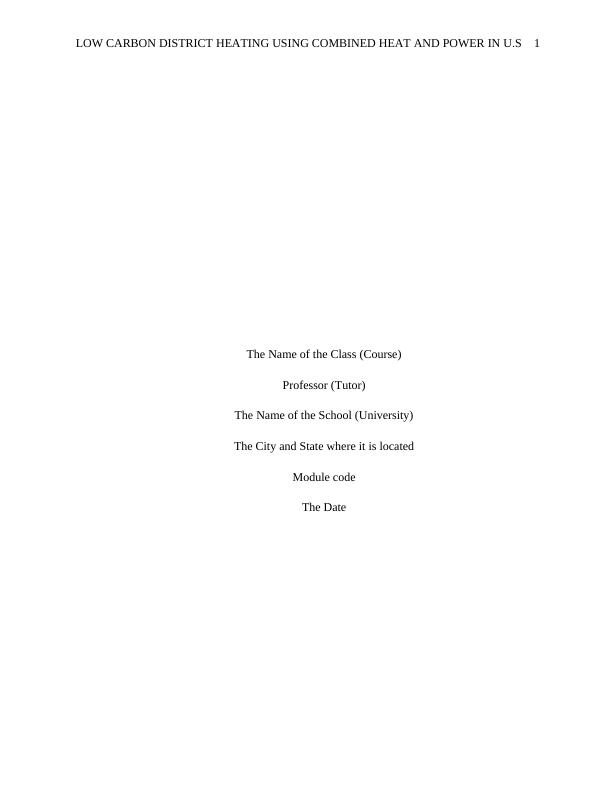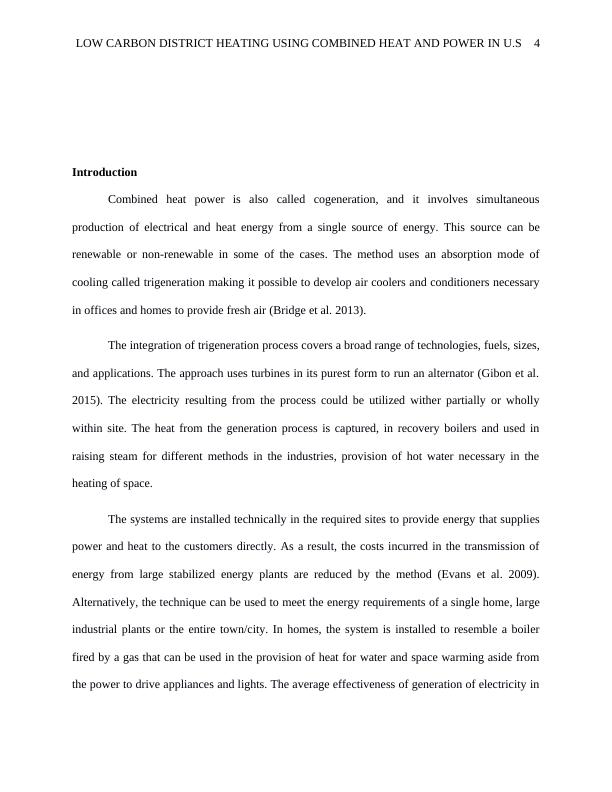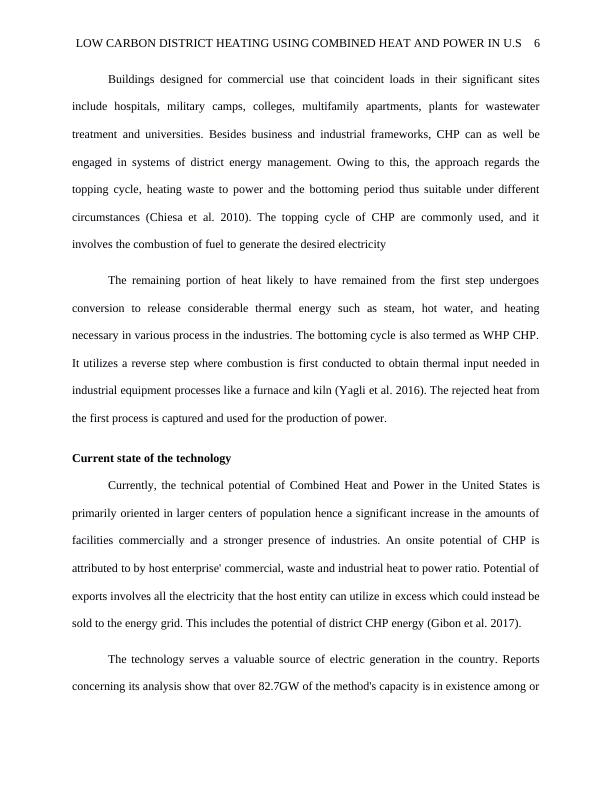Low Carbon District Heating Using Combined Heat and Power in U.S
Investigation of low/zero carbon energy technology for sustainable energy
21 Pages5343 Words41 Views
Added on 2023-01-03
About This Document
This document provides an overview of low carbon district heating using combined heat and power in the United States. It discusses the benefits of this approach, the current state of the technology, its impact on energy systems, barriers, opportunities, and technical developments. The document also explores the potential for implementation in different sectors and the role of utilities in supporting this technology.
Low Carbon District Heating Using Combined Heat and Power in U.S
Investigation of low/zero carbon energy technology for sustainable energy
Added on 2023-01-03
ShareRelated Documents
LOW CARBON DISTRICT HEATING USING COMBINED HEAT AND POWER IN U.S 1
The Name of the Class (Course)
Professor (Tutor)
The Name of the School (University)
The City and State where it is located
Module code
The Date
The Name of the Class (Course)
Professor (Tutor)
The Name of the School (University)
The City and State where it is located
Module code
The Date

LOW CARBON DISTRICT HEATING USING COMBINED HEAT AND POWER IN U.S 2
Executive summary
District heating is a framework for the distribution of heat meant for space and water
heating in commercial and residential areas as they can enhance high efficiencies and low
emission of carbons as compared to gas boilers. The most standard approach is the employment
of a CHP engine that generates electricity from a central point. The heat obtained from engine
cooling can be recycled to provide heat used to warm the family buildings. The method saves
energy and reduces the rate of emissions (Brutonet.al .2016).
Combined Heat and Power (CHP) is often considered as a fresh approach thus efficient in
the generation of thermal energy and electric power from a single source of fuel. In place of
electricity purchase from grids of distributions and burning fuel separately in a boiler or furnaces
in the respective sources, a facility that is commercial or industrial can be utilized to combine the
power and heat to provide the desired services in a single step that is often energy-efficient
(Knizley et.al 2013).
The method addresses different national priorities directly including improvement of the
competitiveness in the United States via a reduction of the costs of operation, increment of
energy effectiveness, reduction of Green House Emissions, development of resiliency and
security in the energy sector as well as leveraging the infrastructure of energy sectors. All these
factors contribute to the growth of the United States' economy (Basso et.al 2017). Stabilization
of the technique has been made possible through the emergence of market drivers including a
friendly environment for the growth of the approach, lower costs of operation hence easy
implementation, initiatives of mitigation developed towards low and zero carbon energy systems,
support from utilities and replicability of the projects (Li et.al 2016).
Executive summary
District heating is a framework for the distribution of heat meant for space and water
heating in commercial and residential areas as they can enhance high efficiencies and low
emission of carbons as compared to gas boilers. The most standard approach is the employment
of a CHP engine that generates electricity from a central point. The heat obtained from engine
cooling can be recycled to provide heat used to warm the family buildings. The method saves
energy and reduces the rate of emissions (Brutonet.al .2016).
Combined Heat and Power (CHP) is often considered as a fresh approach thus efficient in
the generation of thermal energy and electric power from a single source of fuel. In place of
electricity purchase from grids of distributions and burning fuel separately in a boiler or furnaces
in the respective sources, a facility that is commercial or industrial can be utilized to combine the
power and heat to provide the desired services in a single step that is often energy-efficient
(Knizley et.al 2013).
The method addresses different national priorities directly including improvement of the
competitiveness in the United States via a reduction of the costs of operation, increment of
energy effectiveness, reduction of Green House Emissions, development of resiliency and
security in the energy sector as well as leveraging the infrastructure of energy sectors. All these
factors contribute to the growth of the United States' economy (Basso et.al 2017). Stabilization
of the technique has been made possible through the emergence of market drivers including a
friendly environment for the growth of the approach, lower costs of operation hence easy
implementation, initiatives of mitigation developed towards low and zero carbon energy systems,
support from utilities and replicability of the projects (Li et.al 2016).

LOW CARBON DISTRICT HEATING USING COMBINED HEAT AND POWER IN U.S 3
Reports show that each CHP category exhibits approximately 240GW professional
potential within the US 291,000 areas. The paper having tackled the original content of CHP,
then discusses the current state of the method in the U.S, the impacts of its implementation to the
utilization of other fuels, the barriers towards its integration, the opportunities and the technical
developments advised to promote the system's functionality (Görgülü et.al 2016)
Table of contents
Contents
Executive summary.......................................................................................................................2
Table of contents........................................................................................................................3
Introduction............................................................................................................................4
Current state of the technology....................................................................................................7
Impact on the energy systems on other fuels...........................................................................9
Barriers, opportunities and technical developments.........................................................10
Conclusion....................................................................................................................................14
Bibliography.............................................................................................................................15
Reports show that each CHP category exhibits approximately 240GW professional
potential within the US 291,000 areas. The paper having tackled the original content of CHP,
then discusses the current state of the method in the U.S, the impacts of its implementation to the
utilization of other fuels, the barriers towards its integration, the opportunities and the technical
developments advised to promote the system's functionality (Görgülü et.al 2016)
Table of contents
Contents
Executive summary.......................................................................................................................2
Table of contents........................................................................................................................3
Introduction............................................................................................................................4
Current state of the technology....................................................................................................7
Impact on the energy systems on other fuels...........................................................................9
Barriers, opportunities and technical developments.........................................................10
Conclusion....................................................................................................................................14
Bibliography.............................................................................................................................15

LOW CARBON DISTRICT HEATING USING COMBINED HEAT AND POWER IN U.S 4
Introduction
Combined heat power is also called cogeneration, and it involves simultaneous
production of electrical and heat energy from a single source of energy. This source can be
renewable or non-renewable in some of the cases. The method uses an absorption mode of
cooling called trigeneration making it possible to develop air coolers and conditioners necessary
in offices and homes to provide fresh air (Bridge et al. 2013).
The integration of trigeneration process covers a broad range of technologies, fuels, sizes,
and applications. The approach uses turbines in its purest form to run an alternator (Gibon et al.
2015). The electricity resulting from the process could be utilized wither partially or wholly
within site. The heat from the generation process is captured, in recovery boilers and used in
raising steam for different methods in the industries, provision of hot water necessary in the
heating of space.
The systems are installed technically in the required sites to provide energy that supplies
power and heat to the customers directly. As a result, the costs incurred in the transmission of
energy from large stabilized energy plants are reduced by the method (Evans et al. 2009).
Alternatively, the technique can be used to meet the energy requirements of a single home, large
industrial plants or the entire town/city. In homes, the system is installed to resemble a boiler
fired by a gas that can be used in the provision of heat for water and space warming aside from
the power to drive appliances and lights. The average effectiveness of generation of electricity in
Introduction
Combined heat power is also called cogeneration, and it involves simultaneous
production of electrical and heat energy from a single source of energy. This source can be
renewable or non-renewable in some of the cases. The method uses an absorption mode of
cooling called trigeneration making it possible to develop air coolers and conditioners necessary
in offices and homes to provide fresh air (Bridge et al. 2013).
The integration of trigeneration process covers a broad range of technologies, fuels, sizes,
and applications. The approach uses turbines in its purest form to run an alternator (Gibon et al.
2015). The electricity resulting from the process could be utilized wither partially or wholly
within site. The heat from the generation process is captured, in recovery boilers and used in
raising steam for different methods in the industries, provision of hot water necessary in the
heating of space.
The systems are installed technically in the required sites to provide energy that supplies
power and heat to the customers directly. As a result, the costs incurred in the transmission of
energy from large stabilized energy plants are reduced by the method (Evans et al. 2009).
Alternatively, the technique can be used to meet the energy requirements of a single home, large
industrial plants or the entire town/city. In homes, the system is installed to resemble a boiler
fired by a gas that can be used in the provision of heat for water and space warming aside from
the power to drive appliances and lights. The average effectiveness of generation of electricity in

LOW CARBON DISTRICT HEATING USING COMBINED HEAT AND POWER IN U.S 5
the United States has experienced improvements by 3% points to 36% from 33% evaluated from
the 1960s to today.
The system utilizes the ordinary clean domestic wastes to generate thermal energy
required for the different stated functions hence reducing emissions and reducing the costs
associated with the use of energy from larger power plants. As stated in the executive summary
CHP is indeed a commercially available form of energy best suited for various purposes
depending on the scale of consumption. Irrespective of this, the sort of power remains to be an
underutilized asset in the current U.S set-up (Chu et al. 2017).
The approach accounts for almost 8% of the capacity of generation in the United States
as compared to other states like Finland, Denmark, and the Netherlands where the method covers
up to 30% of their generation potential. The recent years have been accompanied by limited use
of CHP due to non-market and market obstacles. However, for policymakers, the outlook of the
approach used is bright at state and federal levels. The reason behind this is the evaluation of the
system's ability to exert merits and contribute to a reliable, clean and energy services are cost-
friendly to be used in businesses and industries (Williams et al. 2012).
Aside from these, the incentives of the state and federal policies have profoundly
contributed to the integration of the system to then-current technologies meant to reduce carbon
emissions in the US. The drivers stipulated form a more significant part in fueling the growth of
CHP and also in the realization of merits posed to the users and the entire nation. (Li et al. 2016).
The approach is most efficient in reduction of the strain from electric grids and lowers the rate of
greenhouse emissions as one of the aspects necessary in mitigating climate change.
the United States has experienced improvements by 3% points to 36% from 33% evaluated from
the 1960s to today.
The system utilizes the ordinary clean domestic wastes to generate thermal energy
required for the different stated functions hence reducing emissions and reducing the costs
associated with the use of energy from larger power plants. As stated in the executive summary
CHP is indeed a commercially available form of energy best suited for various purposes
depending on the scale of consumption. Irrespective of this, the sort of power remains to be an
underutilized asset in the current U.S set-up (Chu et al. 2017).
The approach accounts for almost 8% of the capacity of generation in the United States
as compared to other states like Finland, Denmark, and the Netherlands where the method covers
up to 30% of their generation potential. The recent years have been accompanied by limited use
of CHP due to non-market and market obstacles. However, for policymakers, the outlook of the
approach used is bright at state and federal levels. The reason behind this is the evaluation of the
system's ability to exert merits and contribute to a reliable, clean and energy services are cost-
friendly to be used in businesses and industries (Williams et al. 2012).
Aside from these, the incentives of the state and federal policies have profoundly
contributed to the integration of the system to then-current technologies meant to reduce carbon
emissions in the US. The drivers stipulated form a more significant part in fueling the growth of
CHP and also in the realization of merits posed to the users and the entire nation. (Li et al. 2016).
The approach is most efficient in reduction of the strain from electric grids and lowers the rate of
greenhouse emissions as one of the aspects necessary in mitigating climate change.

LOW CARBON DISTRICT HEATING USING COMBINED HEAT AND POWER IN U.S 6
Buildings designed for commercial use that coincident loads in their significant sites
include hospitals, military camps, colleges, multifamily apartments, plants for wastewater
treatment and universities. Besides business and industrial frameworks, CHP can as well be
engaged in systems of district energy management. Owing to this, the approach regards the
topping cycle, heating waste to power and the bottoming period thus suitable under different
circumstances (Chiesa et al. 2010). The topping cycle of CHP are commonly used, and it
involves the combustion of fuel to generate the desired electricity
The remaining portion of heat likely to have remained from the first step undergoes
conversion to release considerable thermal energy such as steam, hot water, and heating
necessary in various process in the industries. The bottoming cycle is also termed as WHP CHP.
It utilizes a reverse step where combustion is first conducted to obtain thermal input needed in
industrial equipment processes like a furnace and kiln (Yagli et al. 2016). The rejected heat from
the first process is captured and used for the production of power.
Current state of the technology
Currently, the technical potential of Combined Heat and Power in the United States is
primarily oriented in larger centers of population hence a significant increase in the amounts of
facilities commercially and a stronger presence of industries. An onsite potential of CHP is
attributed to by host enterprise' commercial, waste and industrial heat to power ratio. Potential of
exports involves all the electricity that the host entity can utilize in excess which could instead be
sold to the energy grid. This includes the potential of district CHP energy (Gibon et al. 2017).
The technology serves a valuable source of electric generation in the country. Reports
concerning its analysis show that over 82.7GW of the method's capacity is in existence among or
Buildings designed for commercial use that coincident loads in their significant sites
include hospitals, military camps, colleges, multifamily apartments, plants for wastewater
treatment and universities. Besides business and industrial frameworks, CHP can as well be
engaged in systems of district energy management. Owing to this, the approach regards the
topping cycle, heating waste to power and the bottoming period thus suitable under different
circumstances (Chiesa et al. 2010). The topping cycle of CHP are commonly used, and it
involves the combustion of fuel to generate the desired electricity
The remaining portion of heat likely to have remained from the first step undergoes
conversion to release considerable thermal energy such as steam, hot water, and heating
necessary in various process in the industries. The bottoming cycle is also termed as WHP CHP.
It utilizes a reverse step where combustion is first conducted to obtain thermal input needed in
industrial equipment processes like a furnace and kiln (Yagli et al. 2016). The rejected heat from
the first process is captured and used for the production of power.
Current state of the technology
Currently, the technical potential of Combined Heat and Power in the United States is
primarily oriented in larger centers of population hence a significant increase in the amounts of
facilities commercially and a stronger presence of industries. An onsite potential of CHP is
attributed to by host enterprise' commercial, waste and industrial heat to power ratio. Potential of
exports involves all the electricity that the host entity can utilize in excess which could instead be
sold to the energy grid. This includes the potential of district CHP energy (Gibon et al. 2017).
The technology serves a valuable source of electric generation in the country. Reports
concerning its analysis show that over 82.7GW of the method's capacity is in existence among or

End of preview
Want to access all the pages? Upload your documents or become a member.
Related Documents
Low Carbon District Heatinglg...
|18
|4445
|21
Renewable Heat Incentive and Renewable Fuel Standards: A Reviewlg...
|15
|4030
|210
Investigation of a Low/Zero Carbon Energy Technology using Solar Thermal for Buildingslg...
|14
|2915
|421
Chp Modelling Assignment PDFlg...
|20
|5693
|83
Assignment on Sustainable Energy PDFlg...
|23
|6111
|56
Solar Thermal Technologies - Assignmentlg...
|15
|4376
|69
